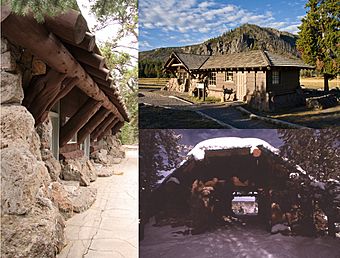Norris, Madison, and Fishing Bridge Museums facts for kids
|
Norris, Madison, and Fishing Bridge Museums
|
|

Clockwise from left: Fishing Bridge, Madison, Norris
|
|
| Lua error in Module:Location_map at line 420: attempt to index field 'wikibase' (a nil value). | |
| Location | Norris Geyser Basin, Madison Junction, and Fishing Bridge, Yellowstone National Park, Wyoming |
|---|---|
| Area | 3 acres (1.2 ha) |
| Built | 1929 |
| Architect | Herbert Maier |
| NRHP reference No. | 87001445 |
Quick facts for kids Significant dates |
|
| Added to NRHP | May 28, 1987 |
| Designated NHLD | May 28, 1987 |
The Norris, Madison, and Fishing Bridge Museums are three special "trailside museums" located inside Yellowstone National Park in the western United States. They were built in 1929. A famous architect named Herbert Maier designed them. These museums are great examples of an early building style called National Park Service Rustic. This style became a model for many other park buildings built in the 1930s. Because of their importance, these three museums were together named a National Historic Landmark in 1987.
Contents
Exploring the Museums
These three important museums are the Norris Museum, the Madison Museum, and the Fishing Bridge Museum. The Norris Museum is located at 44°43′35″N 110°42′12″W / 44.72639°N 110.70333°W. The Madison Museum is at 44°38′32″N 110°51′43.7″W / 44.64222°N 110.862139°W. The Fishing Bridge Museum is found at 44°33′47″N 110°22′40″W / 44.563028°N 110.377694°W.
Museum Locations and Distances
The Madison and Norris Museums are about 14 miles (23 km) apart. The Fishing Bridge Museum is much farther away. It is more than 40 miles (64 km) by road from the other two. Even though they are far apart, all three museums share a similar design.
The National Park Service Rustic Style
All three museums were designed by architect Herbert Maier. He created a unique building style known as National Park Service Rustic. This style uses natural materials to help buildings blend into their surroundings. Imagine buildings made from rough stone and wood shingles. They often have sloped roofs with special clipped ends. Inside, you might see floors made of flat stones and support posts made from peeled logs.
A Fourth Museum and Its Legacy
At the same time these three museums were built, a fourth one was also designed by Maier. This was the Old Faithful Museum of Thermal Activity. However, that museum was taken down in 1971 to make space for a new visitor center. That visitor center has also been replaced since then. The style of these early buildings, especially the three surviving museums, became very popular.
Architect Herbert Maier's Influence
Herbert Maier was an architect who worked for the American Association of Museums and the Laura Spelman Rockefeller Foundation. He designed these museums in Yellowstone. He also designed buildings at the Grand Canyon. Another important building he designed was the National Park Service Southwest Regional Office. This office building is also a National Historic Landmark.
Maier's designs were very important. He helped spread this natural, rustic style of architecture. His ideas were used in many national and state parks and forests. This was especially true for buildings created during the 1930s. Many jobs programs during the Great Depression used his style for new park structures.
See also

